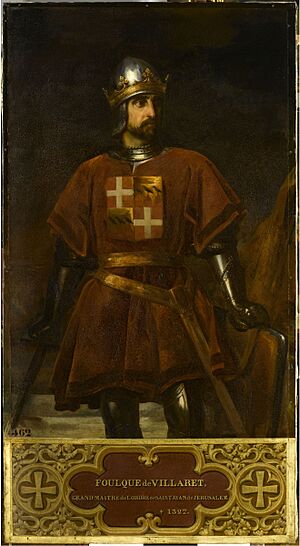Foulques de Villaret facts for kids
Quick facts for kids
Foulques de Villaret
|
|
|---|---|

Portrait by Eugène Goyet, 1841.
|
|
| 25th Grand Master of the Knights Hospitaller | |
| In office 1305–1319 |
|
| Preceded by | Guillaume de Villaret |
| Succeeded by | Hélion de Villeneuve |
| Personal details | |
| Died | September 1, 1327 |
| Military service | |
| Allegiance | |
| Battles/wars | Conquest of Rhodes |
Foulques de Villaret (also known as Folco del Vilaret in Occitan and Folc del Vilaret in Catalan; died September 1, 1327) was a very important leader of the Knights Hospitaller. This was a famous group of warrior-monks who protected pilgrims and fought in the Crusades. Foulques became their 25th Grand Master. He is most famous for leading the Knights to successfully take over the island of Rhodes. He also faced a big challenge when some members of his own Order tried to remove him from power.
Contents
Foulques de Villaret: A Grand Master's Story
Early Life and Rise to Power
Foulques de Villaret came from a region in France called Languedoc-Roussillon. His uncle, Guillaume de Villaret, was also a Grand Master before him. His uncle helped Foulques begin his career in the Order.
Foulques quickly moved up the ranks. In 1299, he became an Admiral, which meant he was in charge of the Order's ships. Two years later, he became the Grand Commander. By 1303, he was the Master's Lieutenant, acting as a second-in-command. When his uncle passed away, Foulques became the new Grand Master in 1305.
Leading the Knights: The Conquest of Rhodes
Under Foulques de Villaret's leadership, the Knights Hospitaller began a major mission: to conquer the island of Rhodes. This important event happened between 1308 and 1309. The Knights also took control of other nearby islands, like Kastellórizo and Bodrum.
After their victory, the Hospitallers moved their main base, or headquarters, to Rhodes. This was a big step for the Order, giving them a strong new home in the Mediterranean Sea.
Challenges and Conflicts
Even though the Knights Hospitaller gained a lot from the end of the Knights Templar (another famous knightly order) in 1312, Foulques de Villaret's plans for expanding the Order's lands cost a lot of money. The Order ended up with many debts, which were not fully paid off until the mid-1330s.
Foulques was seen by some as a difficult leader. People said he became too proud or bossy. In 1317, a group of knights tried to remove him from his position. They went to his home in Rhodini, but his chamberlain (a personal assistant) helped him escape. Foulques fled to the Hospitaller castle at Lindos. There, he was surrounded by his own Order.
In the meantime, the knights had chosen a new Grand Master, Maurice de Pagnac. They wrote to Pope John XXII in July to explain why they had acted this way.
Resolving Disputes and Later Life
To settle the disagreement, the Pope called both Foulques de Villaret and Maurice de Pagnac to his court in Avignon. While the Pope decided, a knight named Brother Giraud de Pins managed the Order.
The Pope decided to reappoint Foulques de Villaret, but only so that Foulques could formally resign. On June 18, 1319, Brother Hélion de Villeneuve was named the new Grand Master. Maurice de Pagnac had passed away by then.
The Pope then appointed Foulques as the Prior of Capua for life on June 29. However, after more problems there, he was moved to the Priory of Rome in 1325. This also seemed unsuccessful. After April of that year, he only received a pension (regular payments).
Foulques de Villaret returned to his home country. He lived as a simple Brother of the Order at his sister's house in Teyran, near Montpellier. He passed away on September 1, 1327, and was buried in a former Templar Church in Montpellier.
| Preceded by Guillaume de Villaret |
Grand Master of the Knights Hospitaller 1305–1319 |
Succeeded by Hélion de Villeneuve |

